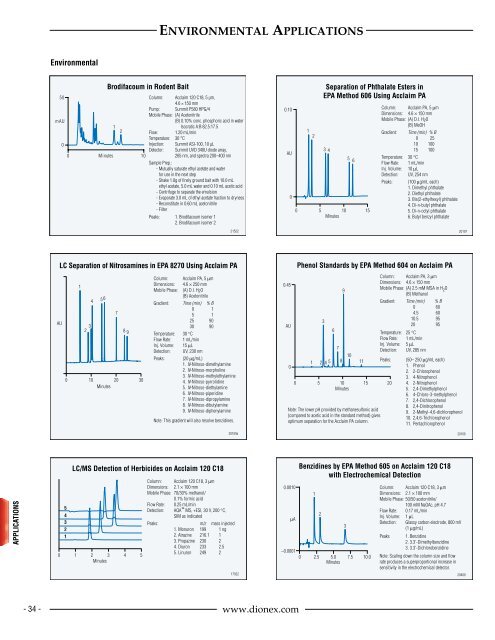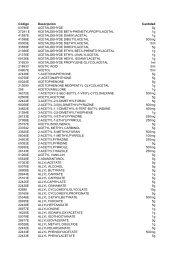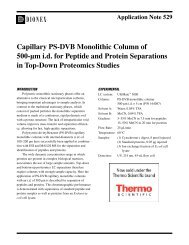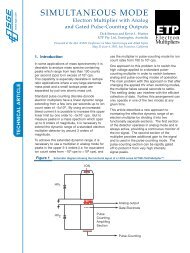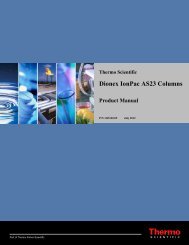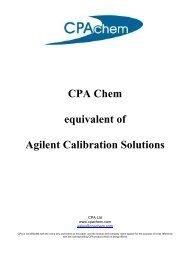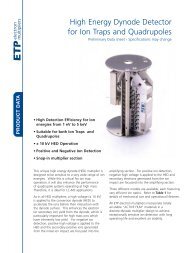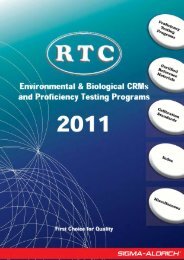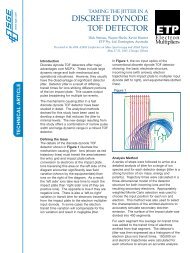ACCLAIM oa - Cromlab
ACCLAIM oa - Cromlab
ACCLAIM oa - Cromlab
You also want an ePaper? Increase the reach of your titles
YUMPU automatically turns print PDFs into web optimized ePapers that Google loves.
Environmental ApplicationsEnvironmental50Brodifacoum in Rodent BaitColumn: Acclaim 120 C18, 5 µm,4.6 × 150 mmPump: Summit P580 HPG/4Mobile Phase: (A) Acetonitrile(B) 0.10% conc. phosphoric acid in watermAU1Isocratic A:B 82.5:17.52Flow: 1.20 mL/minTemperature: 30 °C0Injection: Summit ASI-100, 10 µLDetector:0 Minutes10Summit UVD 340U diode array,265 nm, and spectra 200–400 nmSample Prep.:- Mutually saturate ethyl acetate and waterfor use in the next step- Shake 1.0g of finely ground bait with 10.0 mLethyl acetate, 5.0 mL water and 0.10 mL acetic acid- Centrifuge to separate the emulsion- Evaporate 3.0 mL of ethyl acetate fraction to dryness- Reconstitute in 0.60 mL acetonitrile- FilterPeaks: 1. Brodifacoum isomer 12. Brodifacoum isomer 2215220.10AU012Separation of Phthalate Esters inEPA Method 606 Using Acclaim PA3 45 60 5 10 15MinutesColumn: Acclaim PA, 5 µmDimensions: 4.6 × 150 mmMobile Phase: (A) D.I. H 2 O(B) MeOHGradient: Time (min) % B0 2510 10015 100Temperature: 30 °CFlow Rate: 1 mL/minInj. Volume: 10 µLDetection: UV, 254 nmPeaks: (100 µg/mL each)1. Dimethyl phthalate2. Diethyl phthalate3. Bis(2-ethylhexyl) phthalate4. Di-n-butyl phthalate5. Di-n-octyl phthalate6. Butyl benzyl phthalate20107LC Separation of Nitrosamines in EPA 8270 Using Acclaim PAAU12 3 4 5 60 10 20 30Minutes78 9Column: Acclaim PA, 5 µmDimensions: 4.6 × 250 mmMobile Phase: (A) D.I. H 2 O(B) AcetonitrileGradient: Time (min) % B0 15 125 9030 90Temperature: 30 °CFlow Rate: 1 mL/minInj. Volume: 15 µLDetection: UV, 230 nmPeaks: (20 µg/mL)1. N-Nitroso-dimethylamine2. N-Nitroso-morpholine3. N-Nitroso-methylethylamine4. N-Nitroso-pyrrolidine5. N-Nitroso-diethylamine6. N-Nitroso-piperidine7. N-Nitroso-dipropylamine8. N-Nitroso-dibutylamine9. N-Nitroso-diphenylamineNote: This gradient will also resolve benzidines.20109a0.45AU0Phenol Standards by EPA Method 604 on Acclaim PA13967102 4 5 80 5 10 15 20MinutesNote: The lower pH provided by methanesulfonic acid(compared to acetic acid in the standard method) givesoptimum separation for the Acclaim PA column.11Column: Acclaim PA, 3 µmDimensions: 4.6 × 150 mmMobile Phase: (A) 2.5 mM MSA in H 2 O(B) MethanolGradient: Time (min) % B0 604.5 6010.5 9520 95Temperature: 25 °CFlow Rate: 1 mL/minInj. Volume: 5 µLDetection: UV, 285 nmPeaks:(50– 250 µg/mL each)1. Phenol2. 2-Chlorophenol3. 4-Nitrophenol4. 2-Nitrophenol5. 2,4-Dimethylphenol6. 4-Chloro-3-methylphenol7. 2,4-Dichlorophenol8. 2,4-Dinitrophenol9. 2-Methyl-4,6-dichlorophenol10. 2,4,6-Trichlorophenol11. Pentachlorophenol20106APPLICATIONS054321LC/MS Detection of Herbicides on Acclaim 120 C18Column: Acclaim 120 C18, 3 µmDimensions: 2.1 × 100 mm0.0010Mobile Phase: 70/30% methanol/10.1% formic acidFlow Rate: 0.25 mL/minDetection: AQA MS, +ESI, 30 V, 200 °C,SIM as indicatedµA2Peaks: m/z mass injected1. Monuron 199 1 ng32. Atrazine 216.1 13. Propazine 230 24. Diuron 233 2.515. Linuron 249 2–0.00012 3 4 5 0 2.5 5.0MinutesMinutes7.5 10.017922Benzidines by EPA Method 605 on Acclaim 120 C18with Electrochemical DetectionColumn: Acclaim 120 C18, 3 µmDimensions: 2.1 × 100 mmMobile Phase: 50/50 acetonitrile/100 mM NaOAc, pH 4.7Flow Rate: 0.17 mL/minInj. Volume: 1 µLDetection: Glassy carbon electrode, 800 mV(1 µg/mL)Peaks 1. Benzidine2. 3.3'-Dimethylbenzidine3. 3.3'-DichlorobenzidineNote: Scaling down the column size and flowrate produces a superproportional increase insensitivity in the electrochemical detector.20400- 34 -www.dionex.com


